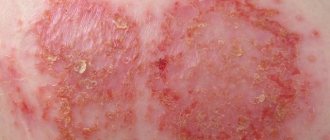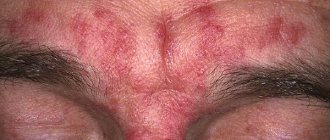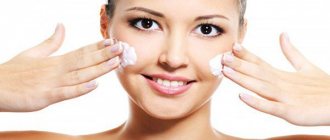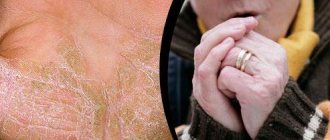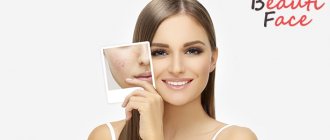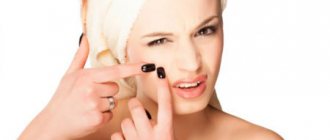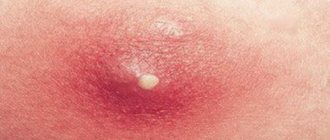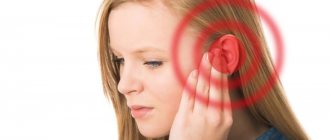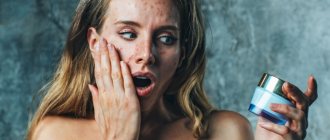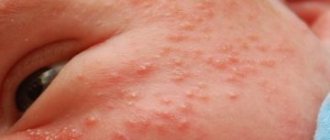Skin allergies in the form of blisters
The appearance of blisters in large numbers on the skin is usually called urticaria. Blisters may cover the entire body. They can even appear in the foot area. Blisters have different shapes and sizes and bring great discomfort to the patient, as in most cases they are accompanied by severe itching.
Before a blister appears, there is redness and a burning sensation on the top layer of the skin. There is liquid inside the blister. Hives do not last long and if you try not to touch the blisters, they will disappear on their own in a few days. If you start to scratch the blisters, you can inadvertently introduce an infection into the open wound. This can lead to bad consequences. It often happens that after scratching the blister may disappear and appear in another place.
What types of allergies are known?
Signs of allergies and how the child’s body reacts to an irritant allow us to understand what the little patient and his doctor had to face:
- dermatitis (contact, atopic),
- eczema,
- hives,
- Quincke's edema,
- neurodermatitis,
- Lyell's syndrome.
Let's give a brief description of each of the listed types of allergies.
Types of allergies in children photo
Contact dermatitis
A distinctive feature of contact dermatitis: it rarely appears on the baby’s face. The disease affects the back, abdomen, neck, arms, legs of infants and children over 1 year of age.
This type of allergy manifests itself as follows: hyperemia, swelling, severe peeling, burning, itching, vesicles with pus or clear liquid.
Contact dermatitis photo
Atopic dermatitis
This form of allergy in a child is difficult to cure. Often the disease becomes chronic. Atopic dermatitis is characterized by acute inflammation of the epidermis: hyperemia, peeling, itching, cracks, rashes, crusts, after which scars remain.
In children under one year of age, they appear on the face, bends of the arms and legs. In older children - in skin folds, on the palms and soles, in the genital area, on the mucous membranes of the mouth and nose.
Photo of atopic dermatitis
Eczema
A type of allergy called atopic dermatitis is often accompanied by eczema. There are several reasons for the appearance of this disease - allergies, weak immunity, disturbances in the functioning of the gastrointestinal tract.
The following symptoms are characteristic of eczema: hyperemia, severe itching, allergic rash (many small blisters that gradually unite into one large one, then burst and become covered with scabs).
Photo of coin-shaped eczema
Hives
Urticaria (urticaria) appears in infants in the form of acute but short-lived attacks. Over time, this allergy in a child becomes chronic.
It received its name for its external resemblance to the blisters that appear after contact with the prickly nettle plant. Its characteristic symptom is the appearance of an allergic rash (red, pink or white blisters surrounded by swelling).
These formations itch very much, burst, and then merge into one large one. This rash is a reaction of the child's body to medications, chemicals, dust mites, cold air or sunlight.
Often, urticaria is accompanied by disorders of the digestive system, viral or bacterial infections.
Urticaria photo
Quincke's edema
A child may experience a sudden acute allergic reaction to chemicals or plant pollen - Quincke's edema. This disease is characterized by an increase in the soft tissues of the face, arms, legs, neck, palms, and feet.
The most dangerous is considered to be swelling of the throat when the child loses the ability to breathe independently. There is no itching, no pain, no fever, but if you have the slightest suspicion of this type of allergy, you should immediately seek help from a doctor.
Quincke's edema
Neurodermatitis
This disease is classified as a neuro-allergic disease. It appears in children over 2 years of age and is often preceded by diathesis. The disease manifests itself in the form of an allergic rash (small blisters of light pink color, which, after scratching, combine into one focus of inflammation).
The skin first becomes covered with red spots without clear boundaries, then scales and seals appear in this place. The illness can last a long time. The nature of the course is characterized by alternating periods of exacerbation and rest.
Neurodermatitis photo
Lyell's syndrome
A severe illness that occurs as an allergy to medications is called Lyell's syndrome. In terms of external signs, it resembles a burn: blisters cover the body and mucous membranes, become inflamed, and swelling appears.
If you notice allergic skin rashes in a child, you should immediately consult a doctor. It is very difficult to alleviate the patient's condition. In three cases out of ten, death occurs.
Leyell's syndrome
Why do skin blisters itch?
The characteristic symptoms that accompany urticaria are the result of a large production of histamine within the body. As soon as the allergen gets inside, the production of histamine begins. Under its influence, a rash occurs on the human body, which is accompanied by unpleasant sensations: pain, peeling, severe itching.
The doctor prescribes antihistamines. Their main function is to relieve histamine and relieve the inflammatory process. To treat a more severe stage of allergy, the patient may be assigned to a hospital. To undergo treatment in a clinic under the supervision of a doctor.
Treating allergies with skin blisters
After discovering blisters on the skin, you should not delay a visit to a dermatologist and allergist. To prescribe the correct treatment, the doctor must determine the specific allergen. An allergy test and blood test will be required.
First you need to block the patient’s contact with the allergen. This will significantly alleviate the patient’s condition and will not aggravate the course of the disease. Next, medications are prescribed:
- Antihistamines . They block the production of histamine in the body. He is the source of negative reactions. The drugs fight the inflammatory process and relieve symptoms. The doctor may prescribe: Diphenhydramine, Tavegil, Peritol, etc.;
- Taking vitamins . They help strengthen the immune system. They are used as a general tonic in the fight against allergies;
- Preparations that contain calcium . It helps prevent fluid from accumulating inside the blisters;
- Passing electrophoresis . The procedure helps eliminate blisters.
After removing the blisters, you need to take care of your skin and use products to prevent allergies. It is also worth reconsidering your diet. You should avoid salt, as it retains fluid in the body. Also, do not abuse fatty foods, sweets, carbonated drinks, and flour products.
The body's reaction to an irritating factor can manifest itself in different ways. One option is an allergy in the form of blisters on the skin. The most common and most unpleasant is urticaria.
Allergy blisters: What to do?
Allergies often manifest as various types of rashes on the skin. Such elements of skin manifestations of allergies include blisters. Allergies in the form of blisters are quite common, especially in children. Let's try to find out what they are.
Causes of blisters
Blisters occur as a result of allergies and are caused by exposure of the skin to various irritants: chemical, physical, biological. So, when insect bites, the appearance of blisters is almost natural.
- contact with medicinal substances applied to the skin in the form of ointments, as well as when taking medications orally and parenterally; -exposure to the skin of toxic substances, especially in industrial conditions: varnishes, paints, pesticides; - physical work without gloves, when the skin of the hands is exposed to harmful substances; -sun and cold allergies; -acute and chronic recurrent urticaria
Blisters can occur on any surface of the skin. Blisters on the hands due to allergies appear upon contact with chemicals both at home (washing powder, dishwashing gels, cosmetics) and at work.
Production factors have a harmful effect on the human body. These are chemicals such as chlorine, metals - cobalt, nickel, lead, chromium, as well as asbestos, coal and others. With prolonged exposure to these factors, occupational diseases occur among people working in hazardous working conditions.
Allergies in the form of blisters on the face often occur due to improper use of cosmetics and cleansers, food allergies, especially in infants, and when taking medications. Often blisters are localized on the skin of the abdomen, lower extremities, and perineum. The reason for this may be allergic reactions to food, to women wearing sanitary pads, or to poor body hygiene.
When hives are a symptom of an allergy, white or pink blisters appear. They are discs with clear boundaries that rise above the skin. The size of such blisters varies: from small - the size of a pea - to extensive. The blister has a dense consistency and is filled with liquid inside. Sometimes the liquid inside the element is not colorless, but takes on a hemorrhagic tint. The blisters burst after a while, a yellow crust appears over them, and then these elements pass without a trace.
The main thing when blisters occur due to allergies is the appearance of skin itching, which is often intolerable. This unpleasant phenomenon is associated with the release of histamine and serotonin, which cause vasodilation and impaired permeability. This is how blisters or urticarial rashes appear on the skin of an allergic person.
The main task of the doctor is to protect the patient from contact with the allergen by correctly identifying substances that have an allergic effect. Only correct diagnosis can get rid of allergies. and including blisters.
General therapy for the disease, antihistamines, and hormonal drugs in difficult cases are also prescribed. Ointments with an antiallergic effect are applied to the site of the rash. These include such as Sinoflan, Hydrocortisone ointment, Oxycort, Flucinar and other ointments. Vitamin therapy, immunomodulators, and sedatives are definitely prescribed.
Folk remedies are also successfully used in the fight against blisters and other skin manifestations of allergies. These include:
- compresses from steamed celery and chamomile leaves; - lotions and baths from the infusion of the string; - taking duckweed in the form of a decoction; - nettle infusion for internal use; -applying dry mustard brewed in boiling water to the blisters. In the treatment of allergies and blisters, methods of traditional and traditional medicine are widely used, but the advice of your doctor is necessary in any case.
Causes of skin blisters
The main factors that contribute to the development of blisters in both children and adults are:
- People prone to allergic reactions.
- This type develops against the background of other chronic diseases.
- Allergic contact and atopic dermatitis leads to the formation of urticaria.
For the human body, the main allergens can be:
- Metals;
- Household chemicals;
- Clothes and footwear care products;
- Chemicals used in the food industry;
- Medications;
- Cosmetical tools;
- Insects.
With such an allergy, various skin rashes appear, which can be in the form of blisters. They differ from each other in shape, size, and location. Scattered throughout the human body, starting from the head and ending with the feet. The patient feels great discomfort, accompanied by severe itching.
In places where rashes appear, the skin is very itchy. It then begins to flush, becoming bright red or pink. Blisters with liquid filler appear. If in doubt, you can check. When a person has hives, when the affected area of skin is stretched, the rash becomes pale.
This type of allergy is characterized by transience. If the blisters are not scratched, they form a crust that falls off after 3–4 days. The rash will disappear completely within a week. Only in this case you need to be sure that the allergen has been removed from contact with the patient.
If you constantly scratch the blisters that appear, the recovery will be delayed. Due to the fact that a crust does not form, a microbe can enter the wound, which will cause the blister to fester.
And also some of the symptoms characteristic of such an allergy are:
- Temperature increase;
- Swelling of the nose, lips, eyelids, tongue, genitals;
- Stomach ache;
- Diarrhea;
- Nausea, vomiting.
A chronic form of allergy is considered when exacerbations continue for 3 months. Such urticaria may not go away in a person for several months or years. This type is also accompanied by such signs as: increased irritability, sweating, sleep disturbance.
Photos showing the main symptoms and causes of the disease can be considered in this article.
Causes of red rash during pregnancy, menopause
Rash during pregnancy is common. Neoplasms in the abdominal area can signal hormonal changes in the female body.
The rash may spread to the area:
- hands;
- backs;
- buttocks;
- hips;
- breasts
Another important cause of rashes is allergies. It can be provoked by:
- Food;
- cosmetical tools;
- cloth;
- plants;
- household chemicals;
- metal jewelry;
- medications.
Allergies usually cause blisters to form and burst. They often become further infected. Allergies are triggered by altered hormonal levels and can cause gestosis
Therefore, it is important to consult a doctor in time
During the summer, a pregnant woman may develop prickly heat. It is a consequence:
- increased sweating;
- wearing synthetic clothing;
- wearing a bandage;
- insufficient body hygiene.
Dermatosis often develops during pregnancy. Usually occurs in the last trimester with strong weight gain. The rash takes the form of red bumps. It does not pose a danger to the fetus and disappears after childbirth. The appearance of a small rash in a pregnant woman indicates the development of urticaria. It is an allergic reaction to food.
Hives may develop. Increasing testosterone levels enhances the function of the sebaceous glands. The sebaceous ducts and hair follicles become clogged more intensely than usual. Red pimples are formed, which are characterized by density and depth. As a rule, they are localized near the mouth, on the chin and neck.
How to cope with the disease?
How to treat such skin changes? It is best to visit a specialist who, having examined all the signs and learned about possible allergens, will prescribe the optimal and effective treatment.
- Remove contact with the allergen both while taking medications and in the future. This will not only help reduce the risk of developing dangerous symptoms, but also make it easier to treat the patient.
- Antihistamines are designed to reduce the level of histamine influence on the patient's body. They help reduce swelling of the affected areas of the skin. There are drugs that act on the entire body or on a specific place. The most recommended are: tavegil, peritol, claritin. These medications must be prescribed by a doctor.
- Glucocorticoids are hormonal drugs used to stabilize cell membranes. They help reduce the spread of the inflammatory process and reduce the signs of allergies. These medications are triamcinolone, kenalog, dexamethasone.
- Calcium-containing preparations help reduce the permeability of the vascular wall. This prevents the formation of exudate (the substance that fills the blisters). These include calcium gluconate and calcium chloride.
- Vitamins help reduce the permeability of vascular walls. It is recommended to use as an additional remedy in the fight against the disease. Vitamins C, A, E are useful.
- Enterosorbents. If a food product is found to be an allergen, then the use of enterosorbents helps remove toxins from the body. This can be regular activated carbon, polyphepan or enterosgel.
All of the medications listed should be taken only after consulting a doctor. Self-medication is dangerous to human life.
Removing fluid
The doctor may recommend opening the blister. We must not forget to use an antiseptic (boric acid, potassium permanganate) and anti-inflammatory (ichthyol, tannin) agent. This will help prevent suppuration of the wound, reduce the separation of exudate and the inflammatory process.
If the blisters on your skin are itchy
When dealing with blisters, it is necessary to use products that help cope with the itching. These are menthol, anesthesin, citric, carbolic, acetic acid. They not only promote rapid healing of rashes, but also help prevent the risk of purulent formations.
You should also worry about changing your dietary habits.
- It is necessary to reduce the intake of salt, which retains water, contributing to swelling.
- Remove quickly digestible carbohydrates from your diet.
- Remove fried foods from your diet. Gradually eliminate eggs, sweets, soda, smoked foods, and citrus fruits.
- Adhere to more vegetarian habits.
Do not use washcloths or sponges on affected areas of the skin. You should wash only with hypoallergenic soap. Do not use cosmetic cream or lotion. To moisturize, you can use Vaseline or vegetable oil.
Allergy prevention
To prevent red spots and blisters from forming, you must follow simple rules.
- Maintain personal hygiene.
- Workout.
- Eliminate stressful situations.
- Remove contact with the irritant. If this is not possible, for example, due to work, then use protective equipment when working with allergens.
- To refuse from bad habits.
Any disease can occur due to human fault. These are, for example, constant stress, consumption of low-quality foods, a sedentary lifestyle, and neglect of personal hygiene.
If you don’t want hives to form, you need to watch your lifestyle. For any manifestations, you should consult a specialist who will help you cope with your allergies.
Video on skin blisters
The condition of a person’s skin can provide a lot of information about health and allows one to suspect the development of pathological processes. The signs of exposure to allergens of various natures on the body are especially pronounced. The patient may experience redness, peeling, pigmentation, and pimples. Skin allergies in the form of blisters are an immune response to a potentially harmful substance. This type of rash is called urticaria. It is accompanied by significant itching of the affected areas, burning and depression of health.
Red blisters on the body: what could it be, what to do if they itch and feel a burning sensation
How to treat red blisters?
The appearance of blisters can be very dangerous, since this symptom signals that one of the vital systems is not working correctly. An allergy indicates the appearance of an irritant, often characterized by a neoplasm on the surface of the skin.
In addition, skin infections are often accompanied by similar symptoms, but we should not forget that we are talking about a serious illness. Therefore, the cause of the appearance should be established and, if necessary, timely treatment should be started.
Blisters may resemble a dense swelling of the upper layer of the epidermis, or have a watery filling. Such neoplasms are often associated with local inflammation of the epidermis. It is important to know that a blister filled with liquid can signal a pathology.
What can cause red blisters to appear?
There are many reasons that can cause such neoplasms on the surface of the skin, both in adults and in children. We suggest considering common reasons:
- An allergic reaction of the body to an irritant.
- Infection.
- Skin disease.
- Other diseases of the body.
Let's look at each point in more detail.
- The formation of blisters on the body is in most cases a symptom of allergies. Allergies can be associated with external and internal irritants.
- External stimuli are certain chemical elements. Spots on the surface of the skin can be associated with the use of new cosmetic products, with the use of new household chemicals, and can also be associated with physical contact with strong reagents: soda, salt, vinegar, acid, chlorine. External irritants include allergies to extreme cold and sunlight.
- Internal stimuli are associated with the direct consumption of certain foods. Quite often, urticaria occurs with the consumption of eggs, chocolate, medications, and fruits. Urticaria is accompanied by severe itching and local redness of the skin.
If symptoms indicate an allergic reaction, the irritant should be eliminated immediately.
Most often, this reaction occurs in children.
- An infection that has entered the body can also manifest itself as a rash on the skin in the form of red blisters.
There are 3 types of infections:
- A viral infection is caused by a person becoming infected with a specific virus; the most common diseases are: rubella measles, chickenpox infection or measles. Treatment of these infections involves absolute isolation of the carrier of the disease.
- Bacterial infection is caused by the appearance of the most common types of bacteria in the body. Diseases caused by streptococcus: streptoderma, scarlet fever.
- Fungal infection. Common diseases: candidiasis or ringworm.
- Quite often the causes can be common dermatological diseases.
- Other diseases include the following:
- Vegetative-vascular dystonia is associated with severe stress. A patient's prolonged stay in a stressful state is characterized by a decrease in the tone of the nervous system, causing characteristic manifestations in the form of blisters.
- Lupus erythematosus. This disease is associated with the autoimmune system; the appearance of blisters is localized on the face.
- Scleroderma. The connective tissues of the body are subject to destruction, with the possible appearance of red formations on the skin, localization of blisters: arms or legs.
How to provide first aid when such neoplasms appear
First aid for the formation of blisters on the surface of the skin will be effective only if it has been established that the cause is an allergic reaction.
The irritant should be eliminated immediately, the room should be well ventilated, if the irritant turns out to be a cosmetic product, the surface of the skin should be thoroughly rinsed with plenty of running water.
This video explains why blisters may appear:
Provided that the reaction is associated with the use of an irritant, the patient needs to drink several glasses of clean still water, and it would also be a good idea to take an antihistamine.
It is permissible to treat the affected area with an existing antiseptic solution to prevent the spread of infection.
The patient should be given complete rest and kept under constant supervision, checking body temperature at regular intervals and monitoring his general condition.
Calling emergency medical care is necessary only in an emergency situation, when the patient’s condition noticeably worsens, signs of shortness of breath appear, body temperature increases significantly, and the first aid provided has not brought results.
Traditional methods of treating blisters on the body
But a complete cure is only possible in combination with medications, a prescription for which only the attending physician has the right to write. Let's look at the most popular methods that our grandmothers successfully used:
- The most effective way to relieve irritation or itching was using lotions made from freshly brewed strong tea. A small cotton swab should be soaked in tea and applied to the affected areas.
- Herbal compresses. A compress requires a fresh herbal decoction; sage, chamomile or string are often used. For the decoction you only need 1 tablespoon of dried herb and a glass of boiling water; the decoction needs to brew, so do not use it earlier than a couple of hours. The broth is carefully decanted and a gauze bandage is moistened, which is subsequently applied to the blisters.
- If the affected area is large enough, then instead of lotions it will be more effective to take a specially prepared bath with a decoction. To do this, use at least five tablespoons of herbs and at least three liters of boiling water; after the decoction has infused, it is added to the prepared bath.
- Carrots have healing properties that help treat skin rashes. For treatment, you need to drink squeezed juice twice a day.
- Aloe leaf juice has a healing effect in the fight against blisters. To do this, you need to cut off a small piece of the leaf and squeeze out its juice; lotions from the juice should alleviate the condition and relieve burning and itching.
- Shilajit ointment.
- Apple cider vinegar, with the addition of water in a one-to-one ratio, will also help eliminate unpleasant symptoms. But you should be careful with the solution, since excessive concentration can lead to burns.
Medicinal treatments
Only a doctor can determine drug treatment for any rashes on a person’s skin, including red blisters. When you visit a doctor, you need to prepare for the possibility of undergoing various tests that can test for infections, bacteria or fungi in the body.
After your appointment, you can be confident that an accurate diagnosis will be made and effective treatment will be prescribed.
The only thing you can take on your own is antihistamines, which can improve the patient’s condition.
But it is important to take medications only during the period of symptoms; relieving symptoms on an ongoing basis with the help of these medications is unacceptable! Prohibited:
- Self-opening of blisters.
- Scratching the affected area.
- Taking medications that were not prescribed by your doctor.
- Using solutions of vinegar or soda on open wounds of the affected area.
What does the prevention of such diseases include?
In order to avoid the appearance of such growths on the skin in the future, you should follow the rules provided for personal hygiene. Wash your hands more often, especially after contact with animals. You should also not change cosmetics and household chemicals frequently.
Frequent ventilation of the room is recommended.
At the first suspicion of an infection, it is permissible to consult a doctor, because a timely diagnosis significantly speeds up the healing process. Red blisters on the body can be symptoms of various diseases; signals from the body should not be ignored.
This video will tell you how to identify lupus erythematosus:
To relieve unpleasant symptoms, there are traditional methods; to treat the disease, you should consult a doctor. The doctor will be able to make an accurate diagnosis based on the data obtained from the test results. Only after a diagnosis has been established can appropriate treatment be prescribed.
Source: //afroditaspa.ru/kozhnye-zabolevaniya/voldyri/krasnie.html
Causes of the rash
Why do blisters form on the skin and itch? They can arise due to external (exogenous) or internal (endogenous) reasons.
Often people suffer due to the ingestion of allergens from the environment, to which an immediate reaction occurs due to hypersensitivity. This condition is characterized by a process - a rapid allergic response to an irritant. The appearance of red blisters can be caused by:
- insect bite (bee, wasp, mosquito, mosquito);
- consumption of food or drinks;
- use of cosmetics (cream, shampoo, soap, decorative cosmetics);
- use of household chemicals (the danger increases if protective clothing or gloves are not worn);
- use of medications;
- some chemicals in the air, especially in concentrations exceeding the permissible limit.
Many people are allergic to flowers, grass, pollen, dust, animal hair, and odors. The occurrence of blisters on the skin of an allergy sufferer can be caused by:
- diseases of the stomach and intestines, blood and lymph, connective tissues;
- pathologies of the endocrine system;
- infections caused by bacteria, viruses, fungi;
- development of tumors (malignant, benign);
- parasite infection.
The main sign is the appearance of red bubbles with liquid. Blisters noticeably protrude above the skin, and the process of their appearance is accompanied by itching. The affected area may itch for a long time, until the rash disappears. The skin around each bubble turns pink or red.
Blisters can cover a significant area. Often the rashes have a symmetrical shape. The bubbles become voluminous due to the presence of liquid in them. A rash of this type can appear anywhere on the body, even on the rough skin of the palms or soles .
- severe swelling of the nose, eyelids, lips, gums, palate, tongue, in some cases the mucous membranes of the genital organs swell;
- increase in body temperature, often rapid;
- nausea, vomiting, diarrhea;
- headache and general weakness;
- increased sweating;
- sleep problems, irritability.
If you don't scratch the itchy blisters, they will crust over and then disappear within 3-4 days. If repeated exposure to the allergen is excluded, the consequences of the problem completely disappear after 7 days.
The disease becomes protracted when the blisters are scratched and pathogenic microorganisms enter them, which provoke a purulent process.
Causes
Blisters occur when there is contact with an allergen. There is an increased release of the active substance in the body - histamine. As a result, the permeability of the vascular walls increases and edema appears.
The reasons may be:
- Intolerance to certain foods and various chemical additives to them (dyes, preservatives, flavors).
- Medications.
- High sensitivity to sunlight, frost. A reaction may develop after visiting a solarium.
- Cosmetics, hygiene products, household chemicals.
- Mechanical irritants (clothing, shoes made of low-quality materials).
- Insect bites.
- Animal fur.
- Infestation with parasites.
- Water, if it contains aggressive impurities.
- Chronic diseases and pathologies of internal organs, resulting in reduced immunity.
- Heredity. If one or both parents are allergic, the risk of developing allergies in the child increases.
- Strong emotional turmoil, stress. In this case, there is an increased release of the neurotransmitter acetylcholine, which provokes the appearance of blisters.
An allergic reaction is more often observed in children, since their immunity has not yet fully developed.
Treatment methods
If allergic blisters appear on the skin, you should not self-medicate. Contacting a dermatologist or allergist will allow you to accurately determine the cause of the pathology and carry out the necessary therapy efficiently and quickly.
Before treatment, diagnostic procedures are carried out to reliably find out which stimulus caused the reaction. The patient is prescribed tests:
- blood for allergen and immunoglobulin E;
- skin samples (scrapings);
- examination of urine and feces for the possibility of infection with parasites.
Complete exclusion of the allergen from life is the main component of a successful prognosis for the patient.
To get rid of allergy blisters, your doctor may recommend several treatment options. If there are suspicions of diseases that contribute to the development of allergic reactions, additional studies and instrumental diagnostics are carried out.
When a disease is detected, the doctor prescribes treatment for the underlying pathology. It is recommended to carry out general strengthening measures and increase immunity. The patient is recommended to undergo sanitation of the oral cavity, examination and treatment of the ENT organs and digestive system.
In some cases, surgery is required to open the body of the blister. You cannot try to remove the contents of the rash on your own.
After the procedure, you need to treat the problem area of the skin with antiseptics and local anti-inflammatory agents (Chlorhexidine, Diclovit).
To get rid of itching, Anestezin, Diphenhydramine, and external preparations with a cooling effect that relieve swelling are prescribed (Fenistil).
Medication methods
To relieve allergy symptoms accompanied by the appearance of blisters with fluid, drug therapy is prescribed . Depending on the severity and extent of the rash, several groups of medications are used.
- Antihistamines (Claritin, Tavegil, Peritol). They completely suppress or reduce the effect of the allergen or histamine. The patient experiences a decrease in swelling of tissues and mucous membranes.
- Hormonal drugs of the glucocorticoid group (Kenalog, Triamcinolone, Dexamethasone). They stabilize cell membranes, which stops the spread of the inflammatory process and relieves severe allergic manifestations.
- To reduce the permeability of vessel walls and prevent exudative filling of blisters, calcium-containing preparations (Calcium chloride, Calcium gluconate) are used.
- Enterosorbents (activated carbon, Polyphepan, Enterosgel).
- Vitamins A, E, C. They complement the treatment, help reduce the permeability of vascular walls, and have a general strengthening effect on the body.
Forms of complications
If allergies are not treated promptly, conditions may develop that pose a real danger to human life.
Quincke's edema
This condition is characterized by the development of allergic edema of the mucous membranes. It can be localized in different organs and occurs in approximately a fifth of patients.
The main danger of Quincke's edema is that it leads to breathing problems.
This pathology is characterized by pallor of the skin and the appearance of shortness of breath. During examination of the oral cavity, swelling may be noticed. If help is not provided to a person in a timely manner, he may die from suffocation.
Anaphylactic shock
This term refers to an acute reaction that can develop literally within a few minutes.
This condition is characterized by inhibition of some important body functions - in particular, a sharp decrease in blood pressure.
In addition, anaphylactic shock is accompanied by breathing problems and wheezing. This is a very dangerous condition that requires urgent medical attention.
